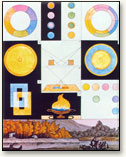Goethe's Color Theory

Johann Wolfgang von Goethe (1749-1832) was the greatest poet, playwright, novelist and essayist in the German language – comparable to Shakespeare and Dante.
Until Johann Wolfgang von Goethe came along, no one had questioned the validity of Newton’s ideas about light and color.
Goethe was both a writer and a scientist. His 1,400-page treatise on color was published in 1810. According to Goethe:
“That I am the only person in this century who has the right insight into the difficult science of colors, that is what I am rather proud of, and that is what gives me the feeling that I have outstripped many.”
Because Goethe misinterprets some experiments, he incorrectly thinks that these experiments show Newton to be wrong.

Goethe’s diagrams in the first plate of Zür Farbenlehre (Theory of Colors) include a colorwheel and diagrams of distorted color perception. The bottom landscape is how a scene would look to someone who was blue-yellow color blind.
Goethe reformulates the topic of color in an entirely new way. Newton had viewed color as a physical problem, involving light striking objects and entering our eyes. Goethe realizes that the sensations of color reaching our brain are also shaped by our perception — by the mechanics of human vision and by the way our brains process information. Therefore, according to Goethe, what we see of an object depends upon the object, the lighting and our perception.
Goethe seeks to derive laws of color harmony, ways of characterizing physiological colors (how colors affect us) and subjective visual phenomena in general. Goethe studies after-images, colored shadows and complementary colors. And he anticipates Hering’s “opponent-color” theory, which is one basis of our understanding of color vision today. Above all, Goethe appreciates that the sensation of complementary colors does not originate physically from the actions of light on our eyes but perceptually from the actions of our visual system.